In the closing paragraphs of my solo wargame report (The Relief of Taipeng Mission, MWAN 117), I made a few remarks about the feasibility of adapting the FIRE AND FURY, rules to wargames of The Boxer Rebellion. The inspiration for such an effort came from two main sources. First, there was the "it left me wanting" experience, when the excellent rules by Larry Brom were used for aforementioned action. As I stated in the report, I could not rightly fault the rules. It was simply the result of having too large a battle. However, I also ran into trouble "attacking" the problem from the other end. That is to comment, with a change of rules and scale, the reverse is true. For example, if the First Relief Attempt is reconstructed, then at a FIRE AND FURY scale of 1 stand represent 160 men, the Western Forces amount to roughly 14 stands. The Boxers and Chinese total approximately 27 stands. (See sub-chapter "The First Relief Attempt," in Peter Harrington's PEKING 1900: The Boxer Rebellion (Osprey Books, #85, pp 34-37).
The second source is the wealth of literature available from other gamers who have adapted (either in whole or in part) the concepts and mechanics of FIRE AND FURY to their favorite or current period of interest. There has been a lot or work done with respect to the Napoleonic Era. (See MWAN Issue 112 or WI 143, for example.) There has also been a number of well-researched efforts by one Mr. Dorrell, who has adapted FIRE AND FURY to 19th century European conflicts like the 1859 War, the Austro-Prussian War and the FrancoPrussian War. (See WI 119 and 136.) For myself, I am waiting to see when or if FIRE AND FURY0 is adapted to Ancients.
Anyway, it was Mr. Dorrell who gave me the idea to try and see if the concepts and mechanics of FIRE AND FURY could be used in 18th century North America. (Please see MWAN Issue 111.) For the purposes of this article then, I would like to amend the paraphrased explanation quoted in that same issue to read: The following revisions comprise an attempt to adapt the concepts and systems of FIRE AND FURY' to simulate battles of The Boxer Rebellion. The modifications / additions are not intended to be immutable, and may be ignored, changed, revised, or even ignored.
ACKNOWLEDGMENTS
To be certain, I am in debt to Larry Brom and his associates for the work they did on the 20th Anniversary edition of "The Sword and The Flame". Supplement I of these same rules served as the basis for the aforementioned solo contest. I am also very much in debt to the team that developed FIRE AND FURY.
The following pages then, are not so much a work of original concept as they are an experimental blend of these two excellent rule sets. (In its present version, the blend is about 80% FIRE AND FURY and 20% The Sword and The Flame.)
FORMAT
In the initial draft of Banners & Bullets, the reference tables were scattered throughout the text. This made sense as it seemed prudent to have the movement rate table under that section of the rules outline concerned with movement. On subsequent reviews, it seemed more prudent to collect these tables (and their modifiers) at the end of the outline. This decision based in part, on ease of reference as well as on the presumption that many readers will be familiar with the game mechanics and procedures used in the FIRE AND FURY rules.
SCALE, ORGANIZATION AND REPRESENTATION
A. Scale
1. For the purposes of this rules set, there is no representative scale of one (1) figure equals 40, 60 or even 80 men.
- A. Artillery models or machine gun models do represent just
one (1) piece of ordnance.
2. As there is no representative or firm figure to real men ratio, there is no table top measurement equals so many meters or yards. In essence, there is no ground scale.
3. With respect to time scale, players may operate under the knowledge that one (1) completed game turn represents the passage of 20 minutes of real time. Hence, three (3) completed game turns would represent the passage of one (1) hour.
B. Organization: Western Infantry, Cavalry and Artillery
1. Western Infantry (Americans, British, Japanese, Russian, etc.) Platoons will have four (4) sections of six (6) figures each, in addition to two (2) command elements: an Officer and NCO. One of the infantry sections may be divided into two (2) if that is so desired.
- A. Two (2) such Platoons will comprise a Company. The
Company will have a Commanding Officer and a Company
NCO. A guidon or standard bearer may also be attached
to this command element.
2. Western Cavalry (Americans, British, Japanese, Russian, etc.) Troops will have four (4) sections of three (3) figures each, in addition to two (2) command elements: an Officer and NCO.
- A. Two (2) such Troops will comprise a Squadron, The
Squadron will have a Commanding Officer and a Squadron
NCO. A guidon or standard bearer may also be attached
to this command element.
3. Cannon and Machine Guns for the Western Forces will be represented by a single piece crewed by four (4) figures. One (1) of these figures will be the crew Officer or NCO. In addition, there will be a caisson or limber represented (2 or 4 horses, mules or oxen). There may be up to two (2) additional figures serving the caisson or limber.
C. Organization: Boxers, Chinese Infantry, Cavalry and Artillery
1. Boxers will be organized into units of 40 figures; four (4) stands of 10 figures each. An "officer" figure accompanies the unit or band, and is mounted individually.
- A. There is no corresponding higher-unit organization for
Boxer units or bands. Players may decide however, to
"assign" a ranking "officer" or leader to a group of three
(3) or four (4) Boxer units or bands.
2. Boxer Cavalry (considered Irregular Horse) will be organized along similar lines as the Western Forces. However, as with their foot units / bands, the Boxer Cavalry will have only one (1) leader figure.
3. Boxer Artillery (again, considered Irregular) will also be organized along similar lines as Western cannon / batteries. However, Boxer guns will usually be emplaced on the field and so, not have caissons or limbers. Additionally, gun crews will not have an Officer or NCO present.
4. Chinese Infantry Platoons will be organized just like Western Infantry Platoons.
5. Chinese Cavalry Troops will be organized just like Western Cavalry Troops.
6. Chinese Artillery will be organized just like Western Artillery.
Representation
1. Western Infantry will be organized in Platoons of four (4) sections, in addition to command stands - the NCO and Officer of the Platoon. (Imperial Chinese Infantry is organized along similar lines.)
- A.The section trays / stands will measure 2.25 inches by 0.75
inches and hold 6 figures. The leader trays / stands will measure
.75 inch by .76 inch and each will hold 1 figure.
 The schematic (not to actual scale) shows a Platoon of Western Infantry in line
formation. Note that each section has 5 Privates and 1 Corporal. (This is done more for
appearance than for leadership factors.) The NCO and Officer of the Platoon are the central
command elements of the Platoon.
The schematic (not to actual scale) shows a Platoon of Western Infantry in line
formation. Note that each section has 5 Privates and 1 Corporal. (This is done more for
appearance than for leadership factors.) The NCO and Officer of the Platoon are the central
command elements of the Platoon.
2. Boxer Infantry (Units / Bands)
- A.Stands for a Boxer unit or band will measure 2.25 inches by 1.25
inches and hold 10 figures. The leader tray / stand for the Boxer
unit or band will measure .75 inch by .75 inch.
 The schematic (not to actual scale) shows a unit or band of Boxers in "line"
formation. Each stand of the band or unit has 10 figures, liberally arranged. This
arrangement meant to reflect the "mass" of Boxers and not, as depicted, 3 distinct ranks
or lines of troops.
The schematic (not to actual scale) shows a unit or band of Boxers in "line"
formation. Each stand of the band or unit has 10 figures, liberally arranged. This
arrangement meant to reflect the "mass" of Boxers and not, as depicted, 3 distinct ranks
or lines of troops.
3. Cavalry Units
- A. Stands for Western or Chinese / Boxer cavalry units will
measure 2.25 inches by 1.25 inches. Each stand will hold 3
cavalry figures. Command elements for Western and Imperial
Chinese troops will consist of an Officer and NCO. For the
Irregular units, there will be just one (1) commander / leader.
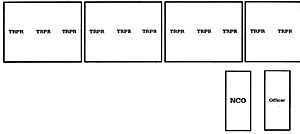 The schematic (not to actual scale) shows a Troop of Western Cavalry formed in
line formation. As an alternative, 3 sections could be forward and 1 could be in reserve. The
Officer and NCO of the Troop are riding to the right rear of the formation.
The schematic (not to actual scale) shows a Troop of Western Cavalry formed in
line formation. As an alternative, 3 sections could be forward and 1 could be in reserve. The
Officer and NCO of the Troop are riding to the right rear of the formation.
4. Artillery or Guns (Machine / Gatling / Quick-Fire Cannon)
- A. Any piece of ordnance will be crewed or served by a minimum
of two (2) crewmen. Normally, the standard will be three (3)
crew plus an Officer or NCO.
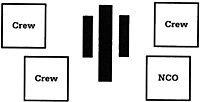 Ordnance and crew may be
mounted on a 2 inch by 2 inch stand, or the piece may be
placed on the playing surface and served by a number of
individually mounted crew (.75 inch by .75 inch stands).
(Schematic is at actual scale.)
Ordnance and crew may be
mounted on a 2 inch by 2 inch stand, or the piece may be
placed on the playing surface and served by a number of
individually mounted crew (.75 inch by .75 inch stands).
(Schematic is at actual scale.)
UNIT EFFECTIVENESS
A. ENERGETIC, EMBATTLED and EXHAUSTED are the three (3) levels of effectiveness which may apply to a unit (infantry and cavalry ONLY) at any one time during the wargame.
1. At no point will any unit be both ENERGETIC and EMBATTLED. Similarly, at no point will any unit be both EMBATTLED and EXHAUSTED.
2. These levels of effectiveness reflect the relative "staying power" of a unit. A unit that is "ranked" as ENERGETIC is one that is considered fresh, rested and at full strength and "ready to go into battle." A unit at the EMBATTLED level of effectiveness is just that, "embattled." In other words, the unit has seen some combat and has had some loss. It is not as fresh, rested or ENERGETIC as it was prior to the start of the engagement. Units that reach the level of EXHAUSTED, are no where near as effective as they once were. These units are still capable of fighting, but will suffer negative modifiers on die rolls for fire and melee combat due to their far-from-fresh state.
3. Effectiveness levels do not apply to artillery pieces/ crews or to machine guns / crews. Guns and crews of guns may only be SUPPRESSED, DAMAGED, ABANDONED or marked as OUT OF AMMUNITION.
- A. Experience ratings however, may be applied to artillery
crews and machine guns. For example, a veteran crew
will tend to shoot better and with more effect than a
Green crew. (Depending on dice roll, this may not always
be the case!)
B. Depending upon their rating (experience, morale, etc.), units will degrade in effectiveness faster or slower than others. Based on my admittedly very limited reading about this conflict, I would suggest that the Western Forces be rated as Regulars, Veterans or Crack troops. For the Imperial Chinese and Boxers, I would imagine that there would be very few Veteran-rated troops. There would be more Regular and even more Green classed troops. For the Boxers, I would suggest that the blanket category of "Irregular" would suffice.
C. As the small number of stands (movement trays) making up each Platoon or Troop does not allow for the general weakening of units - as depicted in the FIRE AND FURY rules, each stand (movement tray) will count for three (3) stands. Phrased another way, the Western Infantry Platoon of four (4) sections or stands, counts for 12 stands in determining fire factors, melee combat results and tracking losses.
- 1. By simple math then, the loss of three (3) stands through
casualties results in the loss of one (1) physical stand from the
unit's basic strength. The loss of these same three (3) stands
does not always correspond to a similar loss in unit effectiveness
rating.
2. Each Cavalry stand (movement tray) will count for two (2) stands in determining combat effects.
3. Each crew member of an artillery piece or machine gun will count as three (3) stands in determining combat effects.
D. Unit Rosters
- 1. Unit rosters shall be prepared prior to the "commencement of
hostilities" on the wargame table.
2. Unit rosters are used to keep track of unit effectiveness, ammunition, and any other notes on the condition of the unit that is not immediately verifiable through the use of status condition markers.
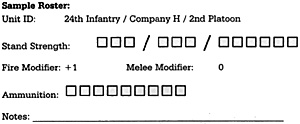 Sample Roster:
Sample Roster:
Unit ID: 24th Infantry / Company H / 2nd Platoon Stand Strength: Fire Modifier: +1 Melee Modifier: 0 Ammunition: Notes:
The above shows the roster for the 2nd Platoon of Company H of the 24th Infantry. Though there are just four (4) physical stands on the playing surface (exclusive of the individually mounted Officer and NCO), the stand strength of this platoon is 12. By the division of stands, one can see that this Platoon is classed as REGULARS. With the loss of three (3) stands, the platoon's effectiveness goes from ENERGETIC down to EMBATTLED. With the loss of another three (3) stands, the platoon's effectiveness degrades to EXHAUSTED.
This particular platoon has a modifier of +1 with respect to small arms fire. There is no modifier attributed for melee.
This particular platoon also has nine (9) "rounds" of ammunition available.
A "Notes" line is also provided for additional comments, if necessary.
E. Status / Condition Markers
1. As a result of movement, terrain and combat effects, a number of status or condition markers may be placed "on" a unit or cannon / gun. These status or condition markers are used in conjunction with a roster to provide a visual indicator of the state of a unit at any particular time during the wargame turn.
DISORDERED Placed on units as a result of casualties, a result of movement through the difficult terrain or, as the result of a poor roll on the Movement Table. Units may accumulate up to four (4) DISORDERED markers.
PINNED Placed on units as a result of casualties, or failure to charge into contact with an enemy. This marker may be placed in addition to a DISORDERED marker.
PRONE Placed on infantry units that have elected to go prone. Prone units also receive a DISORDERED marker to reflect the relative disorganization of formed infantry laying down on the battlefield.
OUT OF AMMO Placed on infantry and artillery units that have expended their allotment of ammunition in the course of the fight. Note: Specific scenario rules may provide for re-supply.
SUPPRESSED Marker placed on any cannon or machine gun stand, reflecting the fact that enemy fire or close combat has "suppressed" that piece. A cannon or machine gun with such a marker cannot fire. To remove the marker, the piece must limber-up and withdraw outside of small arms fire range of the enemy.
DAMAGED Marker placed on any cannon or machine gun stand, reflecting the fact that half of the crew is incapacitated and so, the piece will fire at half-strength or effect for the remainder of the wargame. Upon receipt of another DAMAGED marker, the cannon or machine gun is considered destroyed and is removed from the table.
GAME MOVE SEQUENCE
A. Both sides roll a 1d6 (with no modifiers unless decided upon for the particular scenario) to determine the movement order for that game turn. The winner (high total) of the die roll may elect to move first or second in the two-part, three-phase game turn.
B . The game move sequence detailed on page 18 of the FIRE AND FURY' rules is used in its entirety. The Boxers / Chinese and the Western Forces are substituted for the Union and Confederates. (A slight wording change is made however, due to the scale of this game: "brigades and batteries" should be replaced by "units or platoons and guns. ")
C . In order to recreate a "lack of control" over the battlefield, players will start on their left flank and roll for each unit in their command, progressing to the right flank, until all units have reacted.
Note: I do like the random card movement method used in The Sword and The Flame'". I also like the random movement distance generated by those same rules. However, as I intimated in the comments section of my wargame report, for larger actions, this can prove labor intensive. Further, under these skirmish rules, a player can pick and choose what unit he wants to move with the draw of a card. Indirectly, FIRE AND FURY promotes a similar philosophy. (Page 23: "A die roll is not mandatory for a brigade in good order that remains in its current position and formation.) As a solo wargamer, I would like to have the game "run" itself as much as possible. Therefore, the decision as to which unit moves and when is taken out of the equation. Each and every unit will be diced for on the movement and maneuver table.
Whether that movement and maneuver happens to fit into the overall plan, well ...
I found another idea that I liked while reading through a back issue of WI. In WI 143, Barry Hilton, in "Backing the right Horse, " explains that a commander "rolls a decimal die indicating what percentage of his total units can move in that turn. " (35)
I also toyed with the idea of having units move their full movement allowance (terrain providing). While reinforcing the "lack of control" it did impress me as not too logical, for I would think that an Officer, his NCO and the troops under their charge, would not walk right into or attempt to go through an enemy line. Or even move through a friendly unit, unless circumstances dictated otherwise.
For the time being then, I believe I will stay with the first idea process.
IV. LEADERS, FORMATIONS AND MOVEMENT
A. Leaders
1. Representation
- A. Leaders are present at the platoon / unit level, at the
company level, perhaps at the "brigade" level and, are
represented at the force command level. In addition to the
(usually mounted) officer at the force command level, there
should be an alternate or sub-commander as well as two
(2) to four (4) aides.
B. Western Forces will normally have an officer and a sergeant at the platoon / troop level.
- 1.Artillery and machine guns will usually have an
officer OR a sergeant with the crew.
C. Boxers have leaders as well, but not on the Western scale.
D. Leaders of Imperial Chinese troops will be organized along the same lines as leaders of the Western Forces.
2. Leadership Rating
- A. Borrowing a page from my own rules (which were
adapted / borrowed from ideas set forth in FIRE AND
FURY as well as in ON TO RICHMOND, the ACW rules
from the mind of Paul Koch - see page 42 of MWAN 111),
there will be five (5) ratings of leadership.
- Poltroon -2
Cautious -1
Competent even (0)
Aggressive +1
Exceptional +2
B. Command Radius
- 1. The Command Radius of higher element officers is
15 inches.
2. Unit commanders (NCOs, Officers, Leaders) do not have to be attached - physically touching a tray / stand - to be considered "in command" or having an effect on the unit in question. It is the higher element commanders / leaders that must be physically attached to any part of a unit or band to impart their influence (or non-influence) on the entire unit.
3. Attachment, Detachment, Casualties and Replacement of Leaders is as described in FIRE AND FURY (pps 20-22, 41-42).
B . Formations
1 . For all intents and purposes, the formations detailed on pages 23-26 of the FIRE AND FURY rules are adopted, with the following modifications.
- A. Infantry
- 1. Open Order is a variant of the Line of Battle
Formation, and may be used by Western Troops as
well as Imperial Chinese Infantry. Open Order
formation represents a "looser" organization of the
platoon sections.
- A. This formation is represented by spacing the
stands of the Platoon one (1) inch apart
instead of touching each other, as they would
be in the Line of Battle formation.
B. Fire points / factors are not an issue. The unit will modify its stand to melee and close combat die with a negative one (-1).
2. Square is a "desperation" or defensive formation used by Western Troops when they feel they are going to be assailed from all sides, or used when marching through suspected enemy territory.
- A. The facing or firing sides of the Square are
the only stands counted toward fire factors.
The unit will roll at +2 to stand in melee.
Close combat will engage half of the stands
present. For example, a Platoon Square of
four (4) stands will melee with just two (2)
stands. This, to represent the flow of enemy
against the one side or corner of the Square
and the subsequent involvement of the
nearest troops.
3. Supported Line is simply represented by three (3) stands in the first rank and the fourth stand (presuming a four (4) stand Platoon) centered on the rear of the unit. This fourth stand may be held up to six (6) inches in reserve of the unit front line.
- A.As described in FIRE AND FURY, this
formation may also be depicted by an even
split of the stands between the first and second
rank. Again, the second rank may be held in
reserve, up to six (6) inches from the first or
front rank.
4. "Scouts Out" is a variation on VI. G. from The Sword and The Flame'" (20). In this formation, a section from the parent unit (normally a Platoon) is detached and sent forward with a leader (usually the NCO). Its purpose? To discover concealed enemy forces / positions before it's too late; to secure a piece of ground in advance of the parent unit; or whatever the controlling player decides.
- A.The scouting section is considered to be in
Open Order, and may operate at up to small
arms range from its parent unit.
B. Boxers
1. For ease of movement, Boxer units or bands are mounted four (4) stands to one (1) unit or band. Technically, these units can adopt any of the formations used by their Western or even Imperial antagonists.
- A. Boxers should always be considered to be a
"Mass" target. (Reference The Sword and
The Flame" rules.)
- 1.If more ground needs to be occupied
for example, Boxers may also adopt an
Open Order formation. There is NO
penalty to fire points, stand to melee
or close combat assessed for Boxer
units / bands in this formation.
C. Cavalry
1. Again, the rules for permitted cavalry formations are borrowed in full from the pages of FIRE AND FURY.
- A. As both Western and Imperial Cavalry units
are uniform (four (4) stands in strength),
three (3) stands may be dismounted and
deployed as infantry, while the fourth stand
acts as horse holders.
- 1 . Dismounted Cavalry is ALWAYS
considered to be in Open Order
formation.
2. Horse holders (the fourth stand) form a second line of the unit, and should be placed anywhere from eight (8) to 12 inches from the dismounted and deployed horsemen.
B. Boxer Cavalry cannot dismount.
Note: This rule, especially, is subject to revision.
D. Artillery
- 1.The rules governing artillery maneuver, movement,
positioning and attaching to other units, are adopted from
pages 25 and 26 of the FIRE AND FURY rules.
E. Interpenetration
- 1.The "passage-of-lines ",paragraph is adopted in full from page 31 of
the FIRE AND FURY' rules.
F. Removing Status Markers
- 1. In review, units may have the following status markers placed
on or about their movement trays / stands: Disordered, Pinned,
Prone, Out of Ammo, Suppressed and Damaged.
- A. Status markers are removed as the unit rallies (improves
its state of order - see Maneuver Table) or changes its
formation. For example, a unit that goes from Prone to
.'standing," will remove the Prone status marker.
- 1. Out of Ammo status markers are the exception.
Once these markers are placed, they may never be
removed. (Exception to the exception: If the
scenario provides for a re-supply point or the
sharing of ammunition between units - both should
be out of the line and both should be marked as
Disordered (present thinking ...)
G. Concealment
- 1 .The rules detailing Concealment are adopted in full from I. A. 2. and
VII. D. of The Sword and The Flame'". (pages 18 and 24,
respectively)
RIFLE & ORDNANCE FIRE RESOLUTION
A. Process
- 1. The "Fire Combat Procedure" is adapted from
the FIRE AND FURY rules (pages 34 - 41).
CHARGE AND MELEE RESOLUTION
A. Process
1. Charges are declared by the initiating side. That player must then roll to see if the declared unit does in fact, charge into contact.
- A. If the declaring unit passes the test, the target
unit (defending unit) of the charge must now roll to see
whether they counter-charge, stand to receive the attack
or "melt away" in the face of such pressure.
B. The modified number to pass either test is a 4-10 on a 1d10.
C. Successful passage of the tests results in close combat.
TROOP RATING TABLES (EFFECTIVENESS DEGRADATION)
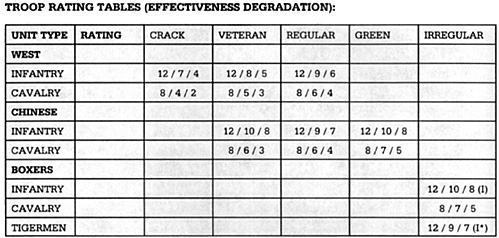
(I): Like the Confederates in the FIRE AND FURY rules, Boxers shall be given a +1 combat modifier for the initial turn of a melee when they are the charging or initiating unit. Mr. Dorrell uses the adjective "impetuous" to describe these aggressive and fanatic kind of troops in "Fire and Furia Francese, " in WI 119. It strikes me as a useful addendum and so, is adapted for use here. The follow-up obligation after a successful melee is also "borrowed."
(I*) Building on the idea of Mr. Dorrell, Tigermen units / bands will be given a +2 combat modifier for the initial turn of a melee when they are the charging or initiating unit.
MANEUVER TABLE
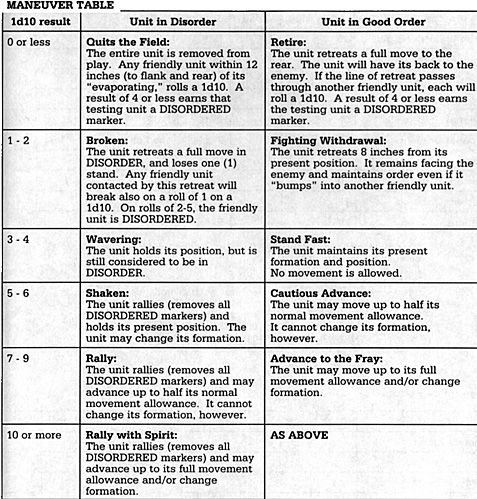
Modifiers:
Energetic Troops +2
Exhausted Troops -2
DISORDERED -1 (for each marker, up to - 4)
PINNED -2
PRONE -1
In column formation +1
In square formation +2
Out of Ammunition -2
Exceptional Unit NCO +1
Exceptional Unit Officer +2
Company Commander within radius +1
Company Commander attached -2 to + 3 modifier
Leaderless -2
MOVEMENT RATE TABLE
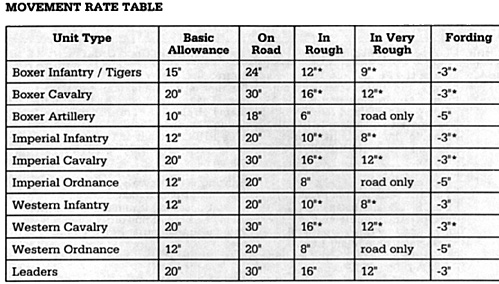
Notes: indicates that a DISORDERED status marker is placed on the unit moving through this type of terrain.
With respect to differentiating between "rough" and "very rough" terrain, one might take terrain features such as light woods or woods and a slight hill or rise to be "rough" terrain. For "very rough" terrain, features such as dense woods, steep hills, gullies and sunken roads might qualify. It should be left up to the players or umpire to decide before it becomes an issue during the game, just what terrain is "rough" or "very rough," and what terrain is not.
Range & Fire Factors
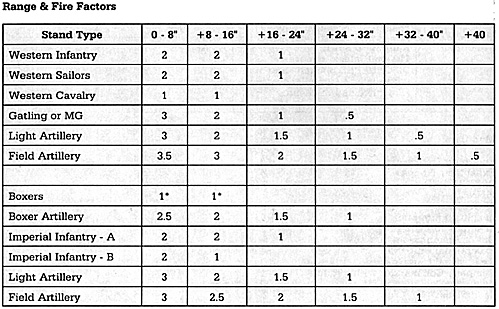
Notes:
(*) is the Fire Factor assessed per PHYSICAL TRAY of the Boxer Unit and NOT of the ROSTER STAND total. So, a full-strength Boxer band unit numbering 12 stands on the roster, will have a fire factor total of 4.
As provided in the scenario or in the Order of Battle for the Boxers, other Boxer units / bands may have an increased Fire Factor.
The range of the Boxer units / bands is less than that of the Western Units to reflect the generally, "poor" armaments of the Boxers. The "restriction" with respect to Fire Factors allowed per unit / band, is also based on a like premise: that the Boxers didn't have full units of riflemen, musket-armed troops. In my estimation, Boxer units / bands were a mixture of men armed with a great number of hand-to-hand weapons and of men armed with whatever small arms they could secure.
Modifiers:
Unit marked DISORDERED* x .5 Fire Factors
Unit marked PINNED x .25 Fire Factors
Unit marked PRONE x .5 Fire Factors
Unit marked OUT OF AMMO NO fire allowed
Unit marked SUPPRESSED NO fire allowed
Unit marked DAMAGED x .6 Fire Factors
Unit firing on target from enfiladex 2 Fire Factors
Unit firing on target from rearx 2 Fire Factors; +2 to die roll
Target is limbered, mounted cavalry or in column formation +1 to die roll
Target is in LIGHT CoverEven; treat as normal
Target is in MEDIUM Cover -1 from die roll
Target is in HEAVY Cover -2 from die roll
Area fire (firing on suspected/concealed) unit(s)x .5 Fire Factors; -1 from die roll
Declared Independent Fire +1 to die roll
(uses 2 ammunition boxes / factors)(if leaders are targeted, + I to that die)
Effects Table
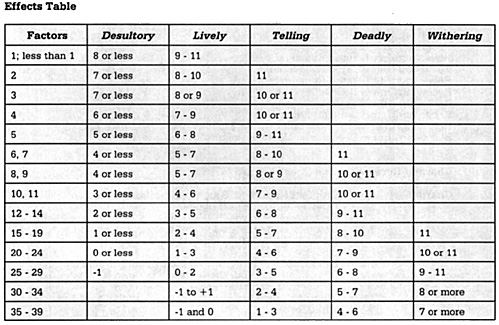
Where:
- Desultory NO effect
Lively Unit DISORDERED or Gun Crew SUPPRESSED
Telling Unit DISORDERED and LOSE 1 STAND or DAMAGE and SUPPRESS a Gun Crew
Deadly Unit DISORDERED and LOSE 2 STANDS or Gun Crew is DESTROYED; Leaders if present, are casualty on a 1-3 on a 1d10
Withering Unit DISORDERED and LOSE 3 STANDS or Gun Crew is DESTROYED; Leaders if present, are casualty on a 1-6 on a 1d10
CHARGE PROCESSES (To charge, To stand):
Charge Modifiers
Charging Unit has Platoon Officer / Leader +1
Charging Unit does not have Platoon Officer -1
Charging Unit attached to higher level Officer + or - Officer quality
Charging Unit is US Marines +1
Charging Unit is Sikhs +1
Charging Unit is rated Energetic +1
Charging Unit is rated Effective Even
Charging Unit is rated Exhausted -2
Charging Unit is rated Impetuous +1
Charging Unit is Boxers +1
Charging Unit is Tigermen +2
Charging Unit has height advantage +1
Charging Unit has friendly units within 8 inches +1 (to a max of +3)
Charging Unit is Cavalry versus Foot +1
Receiving Unit has Platoon Officer +1
Receiving Unit does not have Platoon Officer -1
Receiving Unit attached to higher level Officer + or - Officer quality
Receiving Unit is rated Energetic +1
Receiving Unit is rated Effective Even
Receiving Unit is rated Exhausted -2
Receiving Unit is rated Impetuous +1
Receiving Unit is Boxers +1
Receiving Unit is Tigermen +2
Receiving Unit has height advantage +1
Receiving Unit has friendly units within 8 inches +1 (to a max of +3)
Receiving Unit is Foot versus Horse in Rough +1
Charge Receive Charge Check Failure
Charge:
- 1 = Unit falters, retreats 6 inches away from enemy and receives
DISORDERED marker
2 = Unit falters, receives PINNED and DISORDERED markers
3 = Unit falters, advances 4 inches toward enemy and is marked DISORDERED (cannot contact enemy during move)
4-6 = Roll a 1d6 to determine how many stands lag behind the rest of unit; consider these stands to be stragglers and do not count them in the melee
7+ = Charging unit advances to the attack without reservation; without penalty
Recieve:
- 1 = Unit breaks, retreats a full move to rear, loses 2 stands and is marked DISORDERED
2 = Unit falters, retreats 6 inches to the rear, facing away from enemy and is marked DISORDERED
3 = Unit falters, retreats 3 inches, facing enemy and is marked DISORDERED
4-8 = Unit stands to receive charge
9+ = Unit counter-charges, meeting the enemy force at a point halfway between start lines of each unit
Note: Foot CANNOT counter-charge Horse.
The foot unit will treat counter-charge results as "stands to receive."
CHARGE PROCESSES (To fight):
Modifiers
Attached higher-element leaders -2 to +2
Energetic Troops +2
Exhausted Troops -2
Boxers Charging +1
Tigermen Charging +2
Mounted Cavalry +1
Supported Attack +1
Pursue to Contact +2
Outnumbered by 3:2 -1
Outnumbered by 2:1 -2
Outnumbered by 3:1 - 3
Unit is DISORDERED -1 (to a maximum of - 4)
Unit is PINNED -2
Unit is OUT OF AMMUNITION -1
Each troop stand lost in current phase -1 (to a maximum of - 4)
Defending favorable terrain +1 to +3
Defending unit attacked in flank -3
Defending unit attacked in rear - 5
Unit Rating (Crack, Veteran, etc) + determined in OOB
| Melee Table | |
|---|---|
| Difference | Effects |
| +10 or more | SWEPT FROM FIELD: The defending unit retreats a full move, facing away from the attacking unit(s). It receives a (an additional) DISORDERED marker. Four (4) stands are lost; the integral NCO or commanding officer is killed (for Allied units with an NCO as well as an Officer, the NCO is killed; a 1-5 on a 1dl0 results in the same for the Lieutenant or Captain. Any attached ordnance is captured. Any attached higher-element officer is killed on a 1-2; captured on a 3-5 on a ldlO. Any friendly units within eight (8) inches must roll against unit rating(*), otherwise they too, become DISORDERED. Friendly units in the path of the retreat are automatically DISORDERED. The attacking unit(s) will follow-up, using half of their normal movement allowance. The attacking unit may pursue the defeated enemy or seek to engage another unit. The attacking unit does not roll to close, but the target unit will roll to stand. The attacking unit(s) lose one (1) stand and are marked DISORDERED. Victorious cavalry units will pursue and contact retreating enemy unless a Rally roll is made on the Maneuver Table. Pursuing cavalry shall be marked DISORDERED as well. |
| +6 to 9 | DRIVEN BACK: The defending unit is pushed back six (6) inches, and faces away from the enemy. The defending unit receives a (an additional) DISORDERED marker. Three (3) stands are lost; the integral NCO or commanding officer is killed (for Allied units with an NCO as well as an Officer, the NCO is killed on a 1-5 on a 1d10. A 1-3 results in the same for the Lieutenant or Captain. Any attached ordnance is destroyed. Any attached higher-element officer is killed on a 1; captured on a 2-3 on a 1d10. Friendly units in the path of the forced withdrawal are automatically DISORDERED. The attacking unit(s) may occupy the defender's position or follow-up in a four (4) inch move or, if cavalry, elect to pursue. The attacking unit(s) lose one (1) stand and are marked DISORDERED. Victorious cavalry units will pursue and contact retreating enemy unless a Rally roll is made on the Maneuver Table. Pursuing cavalry shall be marked DISORDERED as well. |
| +1 to 5 | HARD PRESSED: The defending unit loses two (2) stands, is marked with a (an additional) DISORDERED marker and falls back three (3) inches, facing the attacker(s). Any ordnance present is SUPPRESSED and must limber then withdraw a full move from the attacking force. Attacking unit(s) lose one (1) stand and are marked DISORDERED as well. |
| 0 | DESPERATE STRUGGLE: Both sides lose one (1) stand, are marked DISORDERED and, the combat continues. (Subsequent rolls are made with revised modifiers, until a clear victor is determined.) |
| -1 to - 5 | ASSAULT CHECKED: The attacking unit loses two (2) stands, is marked with a (an additional) DISORDERED marker and falls back three (3) inches, facing the defender(s). Any ordnance present is SUPPRESSED and must limber then withdraw a full move from the attacking force. Defending unit(s) lose one (1) stand and are marked DISORDERED as well. |
| -6 to -9 | ATTACK FALTERS: The attacking unit withdraws six (6) inches, and faces away from the enemy. The attacking unit receives a (an additional) DISORDERED marker. Three (3) stands are lost; the integral NCO or commanding officer is killed (for Allied units with an NCO as well as an Officer, the NCO is killed on a 1-5 on a 1d10. A 1-3 results in the same for the Lieutenant or Captain. Any attached higher-element officer is killed on a 1; captured on a 2-3 on a 1d10. Friendly units in the path of the forced withdrawal are automatically DISORDERED. The defending unit(s) follow-up with a four (4) inch advance or, if cavalry, elect to pursue. The defending unit(s) lose one (1) stand and are marked DISORDERED. Victorious cavalry units will advance and contact retreating enemy unless a Rally roll is made on the Maneuver Table. Advancing (pursuing) cavalry shall be marked DISORDERED as well. |
| -10 or less | CHARGE REPULSED: The attacking unit(s) retreats a full move, facing away from the defending unit(s). It receives a (an additional) DISORDERED marker. Four (4) stands are lost; the integral NCO or commanding officer is killed (for Allied units with an NCO as well as an Officer, BOTH are considered lost in the action. Any attached higher- element officer is killed on a 1-2; captured on a 3-5 on a 1d10. Any friendly units within eight (8) inches must roll against unit rating(*), otherwise they too, become DISORDERED. Friendly units in the path of the retreat are automatically DISORDERED. The defending unit(s) will follow-up, using half of their normal movement allowance. The defending unit - now the aggressor - may pursue the defeated enemy or seek to engage another unit. The attacking unit does not roll to close, but the target unit will roll to stand. The defending unit(s) lose one (1) stand and are marked DISORDERED. Victorious cavalry units will advance, pursue and contact retreating enemy unless a Rally roll is made on the Maneuver Table. Pursuing cavalry shall be marked DISORDERED as well. |
Roll against unit rating: On a 1d10, Crack units must roll 4-10; Veteran units must roll 5-10; Regulars must roll 6-10; Green units must roll 7-10; Irregulars must roll 8-10. The die roll is not modified.
Play Test: Taipeng Mission Impossible II
Back to MWAN #119 Table of Contents
Back to MWAN List of Issues
Back to MagWeb Magazine List
© Copyright 2002 Hal Thinglum
This article appears in MagWeb (Magazine Web) on the Internet World Wide Web.
Other military history articles and gaming articles are available at http://www.magweb.com